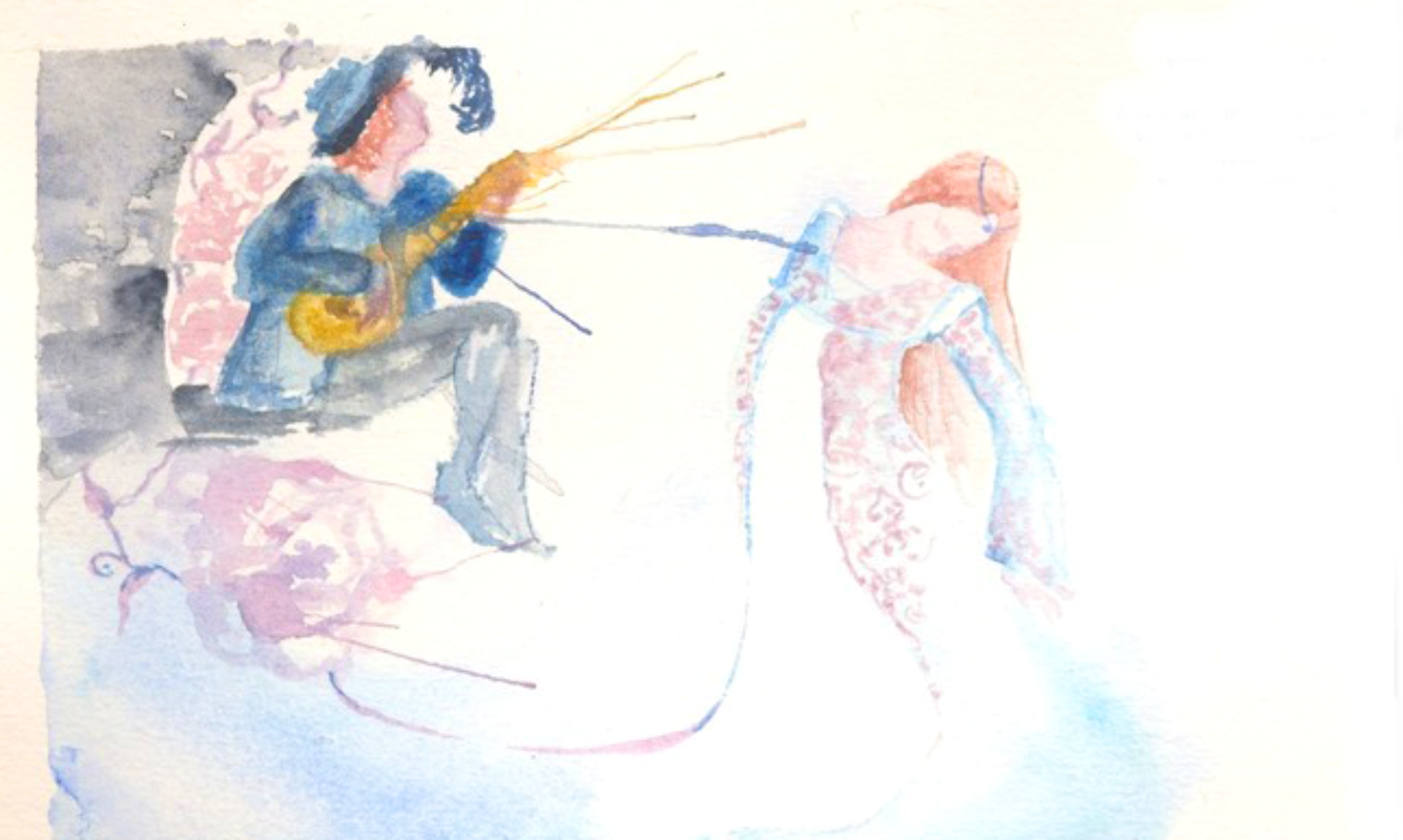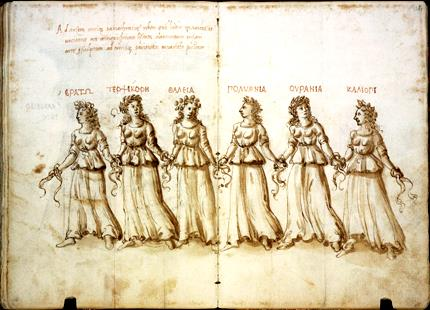Dal 1355 fino alla caduta di Costantinopoli (1453) la famiglia genovese dei Gattilusi governò su diverse isole del nord Egeo; a Samotracia costruirono fortificazioni sia a Khora sia a Paleopolis e una torre sulla foce del fiume Fonias.
In pieno umanesimo, durante i suoi viaggi nel Mediterraneo e in Grecia, Ciriaco D’Ancona[1] disegnò e riportò molti schizzi nei suoi diari giornalieri e tra questi anche quelli del Santuario dei Grandi Dei (Samotracia, 1444).
Dalla fine del Trecento alla prima metà del Quattrocento si apre un periodo di grande rinnovamento e apertura culturale in Italia, in cui fiorì quello che verrà poi chiamato Rinascimento e che contagerà l’Europa tutta. La riscoperta della classicità, volta nuovamente alla Grecia, spinge alla rilettura e alle nuove traduzioni del corpus platonico (tra le quali quelle di Marsilio Ficino), pensiero che per secoli era stato tralasciato a favore di quello aristotelico. L’ideale di bellezza-bontà-giustizia torna ad essere un concetto chiave che permea le principale corti italiane. Il principe espone la sua persona in grazia, misura, buon governo. Si occupa del regno, ma anche di lettere, poesia, musica… e danza. La danza, quale movimento armonico e misurato che si ispira alle movenze celesti, educa e permette di mostrarsi in grazia e armonia, virtù richieste alla nuova “classe dirigente” quattrocentesca.
Con questo programma vogliamo offrirvi alcune tra queste danze di un periodo che condivise uno straordinario spirito di apertura e rinnovamento, di cui anche Samotracia fa parte.
[1] Ciriaco d’Ancona fu il più intraprendente e prolifico ricercatore e studioso di antichità greche e romane del XV secolo, in particolare di epigrafi. La grande accuratezza delle sue annotazioni gli valsero il nome di padre fondatore della moderna archeologia antica.
Από το 1355 μέχρι την πτώση της Κωνσταντινούπολης, το 1453, η γενουατική οικογένεια Γκατιλούζι κυβέρνησε σε πολλά ελληνικά νησιά του βοριοανατολικού Αιγαίου. Στη Σαμοθράκη εκτισαν οχυρώσεις, στις θέσεις Χώρα και Παλαιόπολη και έναν πύργο στην ανατολική οχθη του ποταμού Φονιάς.
Κατά τη διάρκεια του Ανθρωπισμού, ενω ταξίδευε στις μεσογειακές χώρες και στην Ελλάδα, ο Ciriaco D’Ancona σχεδίασε και μετέφερε πολλά σκίτσα στα ημερολόγια του, συμπεριλαμβανομένων των σχεδίων του ιερου των Μεγάλων Θεών της Παλαιόπολης (Σαμοθράκη 1444).
Από τα τέλη του 14ου αιώνα μέχρι το πρώτο μισό του 15ου εμφανίζεται μια περίοδος μεγάλης ανανέωσης και πολιτιστικής ανοχής στην Ιταλία, όπου άνθισε αυτό που στη συνέχεια θα ονομαστεί Αναγέννηση και θα επηρεάσει ολόκληρη την Ευρώπη.
Η ανακάλυψη του κλασικισμού, που οδηγεί και πάλι στην Ελλάδα, προκαλεί την εκ νέου ανάγνωση και τις καινούργιες μεταφράσεις του πλατωνικού έργου (συμπεριλαμβανομένων εκείνων του Marsilio Ficino), πιστεύοντας ότι για αιώνες το έργο του Πλάτωνα αγνοήθηκε υπέρ του Αριστοτέλη. Το ιδεώδες ομορφιάς-καλοσύνης-δικαιοσύνης είναι και πάλι μια βασική ιδέα που διαπερνά τις ιταλικές αυλές. Ο πρίγκιπας εκθέτει τον εαυτό του στη χάρη, το μέτρο, την καλή κυβέρνηση. Ασχολείται με το βασίλειο, αλλά και με τα γράμματα, την ποίηση, τη μουσική … και το χορό. Ο χορός, ένα αρμονικό και μετρημένο κίνημα εμπνευσμένο από τις ουράνιες κινήσεις, εκπαιδεύει και επιτρέπει να δείχνει με χάρη και αρμονία τις αρετές που απαιτούνται για τη νέα κυρίαρχη τάξη του “δέκατου πέμπτου αιώνα”.
Απόψε θα σας παρουσιάσουμε χορούς απο εκείνη την εποχή στην οποία ‘ανθισε η ευρύτητα του πνεύματος και η αναγέννηση μέρος της οποίας πρεσβεύει και η Σαμοθράκη.
From 1355 until the fall of Constantinople in 1453, the Genoese family of Gattilusi ruled on several Greek islands of the northeast Aegean; on Samothrace, they built fortifications in Chora and Palaeopolis, and a single tower at the east mouth of Fonias river.
In full humanism, during his travels to the Mediterranean countries and Greece, Cyriac of Ancona[1] (1391-1452) designed and brought many sketches in his daily diaries, including those of the Sanctuary of the Great Gods (Samothrace, 1444).
From the end of the 14th century to the first half of the 15th century, a period of great renewal and cultural openness appears in Italy, where it flourished what will then be called the Renaissance period and which will affect the whole of Europe. The rediscovery of classicism, once again directed to Greece, prompts the re-reading and new translations of the Platonic corpus (including those of Marsilio Ficino), thought for centuries ignored in favor of Aristotle. The ideal of Beauty-Goodness-Justice is back to be a key concept that permeates the main Italian courts. The prince exposes his person in grace, measure, good government. He deals with the kingdom, but also with letters, poetry, music … and dance. Dance, a harmonious and measured movement inspired by celestial movements, educates and allows to show in grace and harmony virtues required for the new “fifteenth-century” ruling class.
Tonight we offer you some of the dances of a period that shared an extraordinary spirit of openness and renewal, which Samothrace is also part of.
Chiara Gelmetti
[1] Cyriac of Ancona was the most enterprising and prolific recorder of Greek and Roman antiquities, particularly inscriptions, in the fifteenth century, and the general accuracy of his records entitles him to be called the founding father of modern classical archeology.

